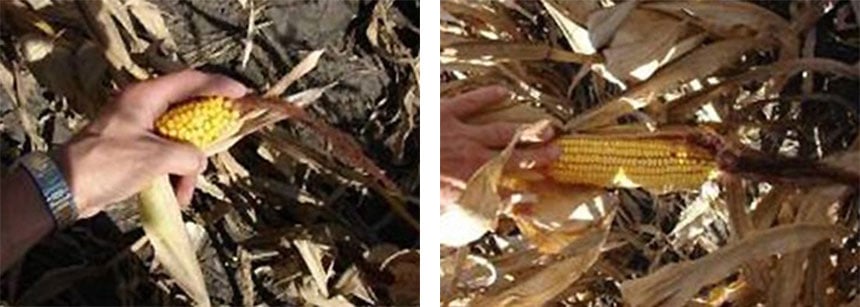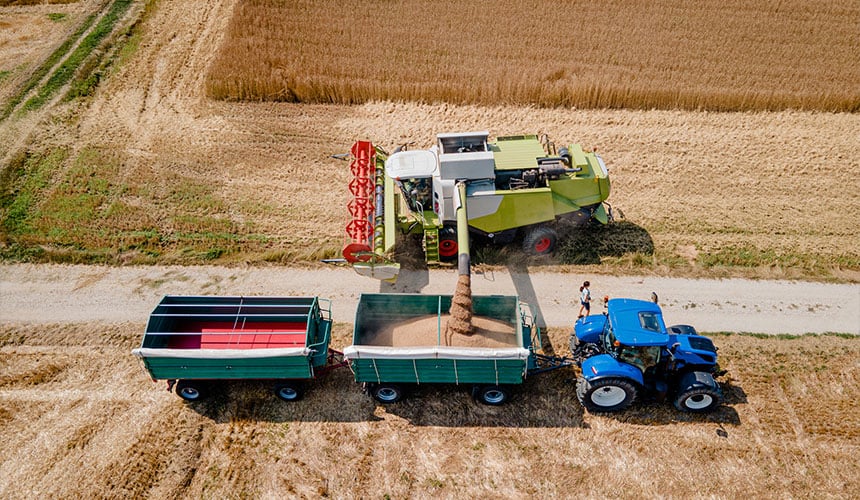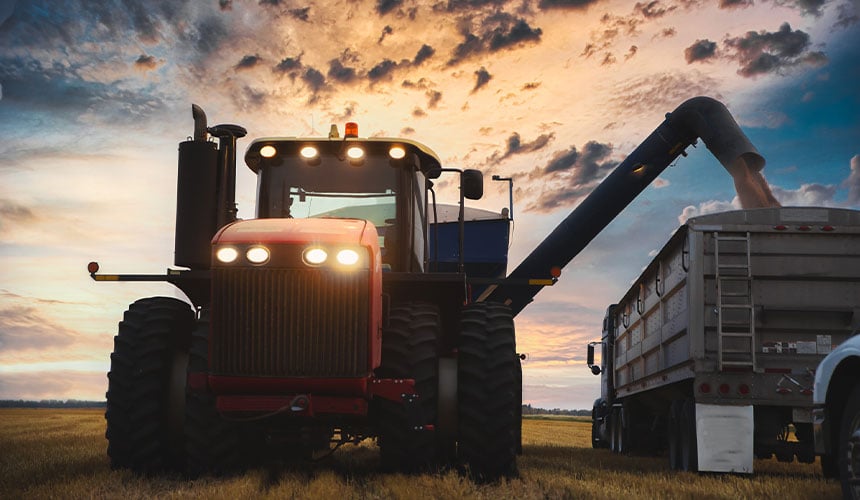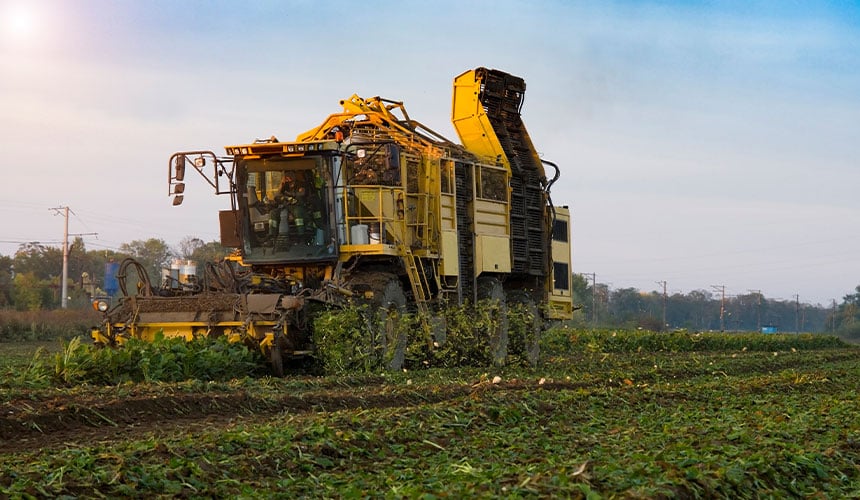Your soil is crucial ; it can be highly productive and serve up good yields for many years, but there are some fundamental conditions which must be respected for this to remain constant.
Among these conditions, avoiding soil compaction is certainly one of the most important and most difficult to achieve, above all at harvest time. Throughout the year you have worked with a low inflation pressure, adapting your work with minimum tillage, perfect control during sowing or spraying and when it comes to the harvest, off you go with a combine harvester that weighs between 25 and 40 tonnes with tyres inflated to 4 bar and the intention of beating the speed record.
. This is certainly not the best way to preserve your soil and ensure future yields. There are solutions, nonetheless, which we will look at in detail here:
1. What are the consequences of the harvesting campaign on your soil?
When it comes to harvesting time, it’s normal to hope for a fast and efficient harvest. This requires the mobilisation of the most powerful harvesters to cover the widest possible area. Unfortunately, these are also the heaviest machines, whose weight may reach up to 40 tonnes or more, depending on the type of harvester.
Yet the first passage of agricultural machinery in a field is responsible for 50 to 85% of soil compaction beneath the wheels, depending on the type of soil and its moisture content. Driving frequently over the same area, especially with heavy equipment such as full trailers, increases the effect of soil compaction by about 5 to 10% per additional passage over the same spot. So the more heavy vehicles you have driving across the field, the greater the soil compaction.
Here are the direct consequences of excessive soil compaction caused by your agricultural tyres:
Erosion and run-off
Excessive packing of the soil accentuates erosion by channelling the surface water run-off which no longer infiltrates into the ground. This tends to limit the even irrigation of the field and the storage of water deep down. But your crops really need these water reserves during the dry season.
Less effective inputs
Soil that is too tightly packed reduces the efficiency of inputs and penalises crop development. Compaction effectively prevents the circulation of water in the ground, causing extensive leaching of inputs or phytosanitary treatments on the surface of the ground.
Lower quality of harvests
Soil compaction blocks root development, which will inevitably have an effect on the quality of the crops, the wheat and the corn of course, but above all the tubers (beet, carrots, potatoes, manioc…) where the harvested part is the root. Sometimes overly compact soil produces irregular or deformed produce, which has less value on the market and has to be sold at cut-price rates.
 Comparison of stifled corn growth linked to
Comparison of stifled corn growth linked to
excess compaction and healthy corn
It is true that the consequences of excess compaction are not immediately visible, but they are likely to have a negative impact on your production over time. The drop in yields is inevitable in the long run and may represent 20%,or even more for certain crops.
2. Managing traffic in the field during harvesting
There are simple solutions for preserving your soil during harvesting campaigns. For example, controlling machine traffic in the fields to reduce the risk of compaction. To do this, the easiest solution is to limit the circulation of other vehicles in the field during harvesting (tractor, trailers, trucks…).

- Leave trucks and trailers outside the field on the edge of the plot of land.
- Use a dumper equipped with low pressure tyres rather than trailers.
- Empty the harvester when it is stationary at the edge of the plot rather than when it is moving in the middle of the field.
This last option avoids any driving through the field with full trailers, thus reducing the risk of soil compaction, given that trailer wheels are used at a high pressure of up to 3.2 bar, or even over 4 bar for the heavier ones.
You will of course lose time by emptying the hopper more often, but if soil preservation is important to you, working with a maximum load is not the solution. Furthermore, the loss of time during the harvest will be easily caught up during soil preparation (as there will be no or less need of a soil decompactor).
You can also use an agricultural dumper rather than a trailer which can be driven with a tyre inflation pressure of 1.6 bar or 1.8 bar. The tractor can also operate at 1.6 bar, if you use wider agricultural tyres on these machines to increase the contact patch with the ground and spread the pressure over a larger area, thus reducing compaction.

3. What are the factors that accentuate compaction
In addition to the heavy weight of your combine harvester, there are other factors that can accentuate soil compaction, for example:
- The travel speed of the harvester: The slower the travel speed of the harvester, the greater the effects of the compaction, leading to more in-depth soil compaction.
- Acceleration and braking: Each change of gear or braking leads to peaks in pressure to the ground to a greater or lesser extent.
- Poor grip: This can be due to the type of soil or to a lower quality tyre, leading to soil sealing and soil deterioration.
- Engine vibrations: Your harvesting machines is made up of several mechanical components, which with the wrong settings can cause more or less intensive vibrations, which encourage compaction.
- Moist soil: Ensure that each operation in the fields takes place at the best possible time, taking into account the type of soil and the moisture content. The wetter the ground, the greater the extent of the compaction.
4. Make the deliberate choice to reduce the load: Adapted pressure = soil preservation
Deciding to drive reasonably in the fields is a great idea, but not always sufficient to preserve your soil during harvesting work. The other option is to reduce the load on the axle of your agricultural machinery to avoid excessive soil compaction.
This compaction is the combination of two factors:
- Compaction linked to tyre pressure: this will impact the arable layer in particular up to 25cm deep, depending on the level of pressure, the type of tyre, the type of soil and the weather conditions.
- Compaction linked to the load on the axle: the compaction may reach the plough pan and the subsoil, depending on the weight on each axle of your machine. The greater the weight, the deeper the compaction.
The impact of the load
The load therefore has a major impact on compaction.
For example, depending on your type of soil, compaction may be 30 cm deep for a load on the axle of around 4 tonnes, 50 cm deep for a weight of 10 tonnes and 60 cm or more with a weight of over 15 tonnes.
With current trends in productivity, increasingly powerful machines are being developed which are more and more efficient but also heavier. The heavier the load, the higher the air pressure in the tyre must be to support the weight of the machinery. Unfortunately, the combined effect of a heavy machine with highly inflated tyres is what is most damaging for your soil.

Limit the load:
If you make the choice to load the hopper a little less, it may be wise to lower inflation pressure to 2.4 or 2 bar, then take care to consider how sloping the land is in your calculation of load transfer.
With IF 900/60R32 tyres, for example, at a pressure of 2.4 bar, you can load up to 10,855 kg for each front tyre.
Depending on the layout of your land and your type of soil, reducing inflation pressure by 1 bar can have a major impact on your soil, and reducing pressure from 3.4 bar to 2.4 bar if you generally manage to keep the load reasonably low is a good option for soil preservation in the long run.
Don’t hesitate to reduce pressure, rather than maintaining high pressure as a matter of habit! Check your effective load on the axle, manage the load distribution and adapt your inflation pressure accordingly.
To help you clearly define the causes of premature wear on your current tyres, we have developed a complete guide for you to download free of charge "How to detect abnormal wear in my tractor tyres"

Most people who read this article have also read some of the following articles:
This information is intended only to make you aware of the technical and functional aspects of agricultural tires and their use. It does not allow you to make a judgment or a definitive conclusion on a given problem. Only your agricultural tire expert is able to make a technical assessment and take a final decision, case by case.